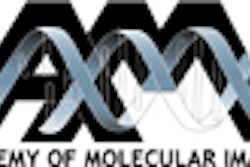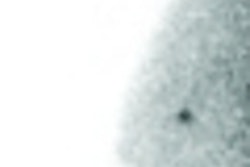
By Michael Tweedle, Ph.D.
Academy of Molecular Imaging

The allure of MRI in this paradigm is undeniable, but targeted agents will be required that are analogous with targeted PET and SPECT agents, such as [11C]N-methyl spiperoneor 11C-raclopride, used to locate and monitor dopamine receptors. Given the general lack of sensitivity of MRI for detecting its agents -- µM LOD for gadolinium (Gd) compared with the nM to pM concentration of biochemical targets -- what are the possibilities for biochemically targeted MRI agents?
Targeted MRI agents
MRI agents are at an impasse. The water-soluble Gd chelates used routinely in clinical medicine were an early start in nearly lock-step follow-up to analogous nuclear medicine agents. Gd(DPTA)2- was modeled after radioactive Ln(DTPA) 2- and Tc(DTPA) used in kidney imaging. Liver imaging with MRI is now possible with Gd(BOPTA)2- and Gd(EOB-DTPA)2-, both DTPA (diethylene triamine tetra acid) analogs with lipophilic, aromatic side chains that are descendants of Tc(IDA)2 (iminodiacetic acid) chelates. Mn2+: 201Tl (Eagle Vision Pharmaceutical, Exton, PA) and Fe Oxides: Tc-S colloids and aggregated albumin are further examples.
Perhaps the last directly derivative compounds are now in or approaching the clinic: Gd(DTPA)2- analogs that bind in vivo to human serum albumin (HSA) and to fibrin. Both of these biochemical targets, along with a very few others, are present in the micromolar and higher concentrations that Gd chelates require, and are also relatively biochemically passive so that toxicity associated with binding them is not so far a significant issue.
The primary practical difference between Tc and Gd can be immediately appreciated in the packaging of the commercial products. Tc kits usually arrive with a few mg of white powder in the vial, while Gd chelates are delivered as 20 mL of a 0.5 M solution, formulated to inject 7-21 mmol, or about 4-12 grams, per patient. To move the NM-MRI follow-up applications further than a very few high-capacity targets, to the nM-pM receptor/acceptor/transporter regime, makes an extraordinary set of demands on the chemistry and biology of the MRI agents.
Gd(III) chelates are water proton relaxation catalysts, and as such their signal-altering efficiency can be increased through manipulation of the ligand structure. The T1 of water protons, a primary component of the MRI signal, is ~106-fold shorter when the water molecule coordinates to Gd than it is in bulk or tissue water. Gd relies on multidentate ligands, mainly polyaminocarboxylates, for stability against hydration and ultimate precipitation of Gd hydroxides.
These are insoluble, toxic, and far less effective relaxation catalysts. Commercial chelating ligands use all but one of the coordinating positions on the Gd3+ ions, leaving one position open for a coordinated water molecule. That water molecule rapidly exchanges with bulk water, relaxing each bulk water molecule as it attaches briefly (µs to ns lifetimes) to the Gd ion, thus propagating the relaxation of the bulk water whose protons are detected in the image. Increasing the detection sensitivity for Gd has involved three research pathways: increasing coordinated water number, increasing the kinetics of interaction with the water protons, and reliance on massive localizing of Gd.
An ideal Gd chelate, pending some clever chemistry, could probably have as many as three coordinated waters rather than one, and still maintain stability. It may be that the structure requires water on nonadjacent coordination positions, however, to maintain enough stability against hydration. Whatever the solution, it is apparently still awaiting invention.
Optimizing the kinetics of interaction between the Gd and water protons it relaxes is the second way to increase effectiveness. The prevailing theory governing dipole-dipole interactions within Gd-OH2 allows for an improvement factor of ~75 in the inner sphere relaxivity per water molecule.
Assuming three water molecules, a 3 x 75 = 225-fold increase per Gd is possible in the second-order catalytic rate constant governing effectiveness, called relaxivity, compared to commercial molecules. However, only 50%-75% of the relaxivity increase is likely to show up as MRI signal increase at 0.5-1.5 tesla.
In addition, relaxivity is magnetic-field-dependent, and the fields are increasing. At 3 tesla there will likely be a dramatic reduction in the inner sphere relaxivity for these hypothetical super-Gd chelates. The extra sensitivity afforded by better chelates is highly desirable for a variety of experiments, but will not take Gd-chelates’ LOD from the current ~ 30 µmolar to the needed nM - pM.
Various schemes to increase sensitivity have been devised, including accumulation methods where Gd is taken into cells by re-expressing targets, Fe oxide particles that multiply the number of paramagnetic centers per targeting ligand, and multimeric/polymeric Gd chelates.
In principle, some receptor/polymer combinations could muster the concentrations required for MRI. But so far most desirable targets have insufficient ability to accumulate. Clusters are either too small and insufficiently effective or so large they are restricted largely to the blood stream by their size, and are therefore restricted to the same small pool of targets as ultrasound imaging.
These considerations have led major pharmaceutical companies to make target choices such as Gd(DTPA)4-peptides targeted to fibrin (Epix Medical, Cambridge, MA/Schering AG, Berlin), which has very large target areas in which to accumulate the Gd-peptide. Likewise, [HSA] ~0.5 mM in human blood lends itself to targeting with HSA-binding Gd chelates (Epix/Schering AG and Bracco, Milan, Italy). The clinical usefulness of these agents in drug development and otherwise remains to be determined, but it is clear that in both cases the compounds show strikingly contrasted MRI.
By Michael Tweedle, Ph.D.AuntMinnie.com contributing writer
June 11, 2004
Michael Tweedle is a council director of AMI's Society of Non-Invasive Imaging in Drug Development (SNIDD). He is also president of Bracco Research USA in Princeton, NJ.
Related Reading
Part II: Targeted MRI agents currently in development, June 11, 2004
Dual-contrast MRI susses out more liver metastases than FDG-PET, May 7, 2004
Radioactive microsphere therapy an option for liver cancer with poor portal flow, April 29, 2004
US, MRI challenge CT for classifying renal cell carcinoma, June 17, 2003
ASNR papers highlight Combidex for tumor imaging, April 30, 2003
Copyright © 2004 Academy of Molecular Imaging




















